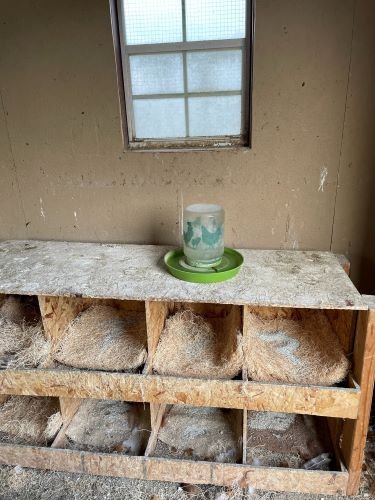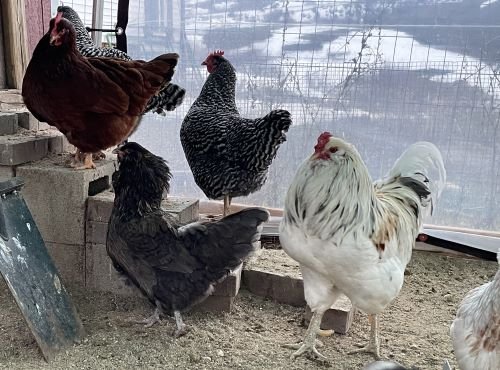Should you keep food and water inside the chicken coop or outside?
This is one of the most frequent questions I get asked by beginners, and it’s one that always surprises me. It seems such a tiny thing.
Once you’ve raised chickens for a while, so many things become second nature. You forget that at one point you had to figure out these little details—these tiny things—too… And you forget just how frustrating it could be to find the right information.
So, I’m going to answer this question for you as succinctly as possible, and then we’ll get into the nuances.
Should you keep feed and water inside the chicken coop or outside? Feed and water are best kept outside the coop because they can lead to unsanitary housing conditions if kept inside. However, if chickens are hesitant to leave the coop for any reason (e.g., cold weather, fearfulness, etc.), feed and water should be kept inside the coop.
In this article, you will learn:
Why most chicken keepers don’t leave feed and water inside their coops
When you should consider keeping feed and water in your coop
How to keep feed and water inside your coop safely
This post contains affiliate links for my favorite products from Amazon. As an associate, I earn from qualifying purchases at no extra cost to you.
Why most chicken keepers don’t keep feed and water inside the coop
One word. Health.
In many ways, keeping feed and water outside in the run is more sanitary.
Feed spillage is a major problem with most chicken feeders. Chickens have very strong foraging instincts and will vigorously scratch feed out of the feeder and onto the ground or floor.
Here you can see my chickens have scratched large amounts of their feed out of their feeder and onto the ground. They just can’t help themselves!
When this happens inside the coop, the feed gets mixed into the bedding.
Over time, that spilled feed can provide sustenance for pathogen growth, including dangerous molds. Spilled water, too, will add fuel to this fire.
Spilled feed can also result in greater insect and rodent activity inside the coop. And simply having feed and water available in the coop in the first place may attract insects and rodents.
All bad things.
You can, however, prevent most of these bad things from happening if you follow a few simple steps (described in detail at the end of this article).
Another good reason to keep food and water outside is because doing so encourages chickens to spend more time outside. The more time they spend outside, the less poop you get in your coop. The less poop you get in your coop, the easier it is to keep it clean.
Keeping your chicken food and water outside in the run ensures a cleaner coop.
Why you should consider keeping food and water in your coop anyway
Clearly there are advantages to only keeping food and water in the run. But you’ll also find some advantages to keeping food and water in the coop too—especially water.
Why I keep water in my chicken coop at all times
I, personally, don’t keep feed in my chicken coop regularly. (You’ll see in the next section that I do keep feed in the coop under special circumstances.)
I do, however, keep a small waterer inside my large, shed-style chicken coop. This is simply because with more opportunities to drink, chickens will drink more.
I keep a small waterer inside my large, shed-style chicken coop on the nesting boxes.
I’ve found this is especially true at bedtime. Chickens will go into the coop, find a comfortable roosting place, then notice the waterer on the nesting boxes. They’ll hop over, drink some, and then go back to their roosting position.
It doesn’t matter that there’s also a larger waterer right outside the coop they could have drank from before entering. Many pass right by that when the light starts dimming around bedtime.
The small waterer inside the coop is especially helpful for chickens during temperature extremes. Because both very hot and very cold weather are stressful for chickens, and because water is so vital for everyday functions, I like for them to have that extra opportunity to drink.
And I find this is ESPECIALLY important in the summertime.
Temperatures here in Southwest Idaho are frequently in the 90s and 100s—miserably hot! Water is crucial for preventing heat stroke (and also for ensuring egg production), so I like to have that extra waterer inside the coop. Not only do the chickens appreciate it at bedtime, but I’ve also seen a hen pop out of her hot nesting box mid-lay, drink the water, and hop back in.
Why keeping food and water in your coop is necessary during stressful periods
When your chickens undergo a period of high stress, they can be hesitant (or downright terrified) to leave the coop.
Increased stress may come in the form of simple physical stress, or it may come in the form of traumatic emotional stress.
Chickens under physical stress may not leave the coop for food and water.
Physical stress can take a few different forms.
One of the most common physical stressors is temperature.
If it’s really cold outside in your run, some chickens will prefer to stay in the coop if the coop is warmer. If feed and water are available inside, they’ll consume more. Chickens really need those calories to stay warm. So, if you notice your chickens aren’t leaving the coop much during the winter, consider providing feed and water inside.
Additionally, if a chicken is injured, sick, or just not feeling very well, she may be hesitant to leave the coop. Giving her some food and water inside the coop during recovery will be very much appreciated and better for her health.
Chickens under emotional stress may not leave the coop for food and water.
When chickens feel unsafe, they may be hesitant to leave the coop.
A recent predator attack or scare is one of the things that will make your chickens feel unsafe. They may not want to leave the coop for several days or even weeks afterward.
But chickens also may feel unsafe when they feel threatened by other flock members.
For example, I once had a rooster (Perly) who felt very unsafe around another rooster (Rufio). If Rufio was outside in the run, Perly would stay in the coop, and vice versa. Because Rufio spent most of his time outside, Perly stayed in the coop for most of the day. I made sure Perly had food and water in the coop until he and Rufio were able to work things out between them.
Rooster Perly with some of the girls in the chicken run.
Another common situation that results in chickens being afraid of flock mates is integration.
Any time you add new chickens to an existing flock, you’ll likely find that some of your chickens become very fearful of their new flock mates. That’s a good time to put food and water in the coop for any chickens who are hiding out there.
Chickens also feel unsafe when any major change happens in their lives.
For example, moving chickens to a new environment tends to be terrifying for them. So, when you move chicks from their brooder to the coop, or your move adult chickens to a new coop or run, they may be hesitant to leave the coop. They may choose to become dehydrated and malnourished, rather than leave the safety of the coop for food and water.
You need to do everything you can to make sure your chickens are eating and drinking when they’re under stress.
When chickens are under a high state of stress, they need food and water more than ever to help support them through the rough time. Furthermore, if they don’t get enough food and water, they may go into a molt, which is incredibly taxing on them. You don’t want them molting when they’re also dealing with other stressors.
So, even if you don’t want to keep food and water inside your coop permanently, I highly recommend being open to providing it inside temporarily when your chickens need it.
How to keep food and water inside your coop safely
The key to keeping food and water inside your coop safely is to prevent spillage.
You can do this by hanging the feeder and waterer or by putting them on a platform, like these. The goal is to get the feed and water at the height of the chickens’ necks. You want it low enough for them to access, but too high for them to easily scratch at it and make a mess.
Or you could use a feeder and waterer with legs attached.
I saw this feeder and waterer at my local farm supply store and snapped a quick photo. I haven’t personally used this type, but I may try this style of waterer in the future.
Perhaps the easiest way to prevent feed spillage is to use a Grandpa’s Feeder. This is the only feeder I use now for my chickens. It has an enclosed design so the chickens can’t scratch any food out of it.
Below, you can see one of my hens, Sasha, demonstrate how the feeder works:
The Grandpa’s feeder is also excellent for keeping birds and rodents out of the feed. Most birds and rodents are too lightweight to be able to open the feeder.
You could also use a no-waste feeder where chickens can only access the food by putting their heads inside of it, like this one.
However, I’ve found my chickens don’t like those feeders as well. Eating is a very social activity for chickens, so they prefer feeders they can eat out of together at the same time.
Chickens love a feeder that allows them to eat simultaneously!
You could also use a nipple waterer—these are less likely to leak or spill.
One last thing.
I’ve seen some chicken keepers claim that you should never keep food and water in the coop because it attracts mice and rats. These keepers tend to have dirt floors in their coops, which provide easy access to rodents.
This is not a problem I’ve ever had in any of my coops. If you are having this problem, I recommend putting a floor in your coop—even if it’s just a floor of hardware cloth (deep underneath the bedding) to keep rodents out.
For more on chicken coop floors, see my articles:
Lastly, another thing you can do to keep conditions clean in your coop is to change the bedding frequently. If you’re finding a lot of feed is getting spilled into your bedding, but you’re changing that bedding weekly, that spillage is unlikely to cause adverse health effects.






